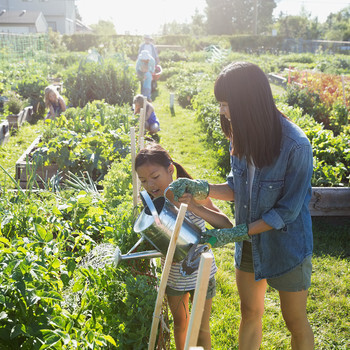You don't need a backyard to grow flowers or vegetables.

Community gardens—or gardens organized and operated by governments, non-profits, schools, and individuals, with plots for rent and enough duties to go around—are growing across the country: In New York City, for example, there are at least 550 community gardens with 20,000 members. According to Levi Gardner, founder and co-executive director of Urban Roots, a community farm, market, and education center in Grand Rapids, Michigan, it's very easy to see why. "What is attractive to people about community growing is the chance to build community and a sense of working toward a common goal—and then, enjoying the products of their hard work," he says.
If you're interested in participating in a community garden, the first step is finding one. You can see a list of gardens on the website of the American Community Garden Association, a nonprofit whose members are professionals, volunteers, and supporters of community gardens everywhere. Or, you can speak to local nursery staff, who might be able to point you in the right direction, says Natalie Walsh, a board member of the ACGA and master gardener herself. "Then, go visit," Walsh suggests. "Every community garden is as unique as the people it serves." And once you've found a community garden you love, here are four ways you can get involved.
Reserve a plot and plant.
Most gardens offer small plots—somewhere in the neighborhood of 4-feet by 8-feet in size, says Walsh—for rent or a small donation. According to Gardner, fees might range from as little as $5 to as much as $50 a month, while other gardens might ask for a $20 yearly donation. "It's often just to help defray some tools or administrative costs," Gardner says, as most gardening tools—think: hoses, shovels, wheelbarrows, and more—are usually provided by the community garden. Tending to your plot could take as little as 30 minutes a week, Walsh says, so it's a great way for beginners to dip their toes into growing vegetables.
Fundraise for your garden.
"Most community gardens have little to no funding," says Gardner, who adds that "they may be fueled by excitement and passion—but there are few dollars for staffing, administrative support, or new tools." Because of that, many community gardens need members to help them raise funds so they can continue to operate. "Whether hosting a fundraiser, writing a grant, or donating to the organization yourself, fundraising will always help community gardens," says Gardner.
Weed community spaces in the community garden.
Another easy way to help your community garden is to weed its shared spaces—places where the garden has placed plants to aid pollination or support butterflies, for example, says Walsh. Those spaces "aren't any one person's garden but a community effort," she explains. "They needed to be tended and it is a great way to get to know the garden." Walsh suggests becoming familiar with three or four common weeds before you attempt to tend to these public spaces, however.
Make a new friend or two.
As Gardner points out, "without people and actual relationships, there is no 'community'" in a community garden. That's why he encourages people who join their local gardens to get to know the people who are planting next to them. "The health and vitality of the place is nothing without relationships—and so, getting to know people will only make it better," Gardner explains.